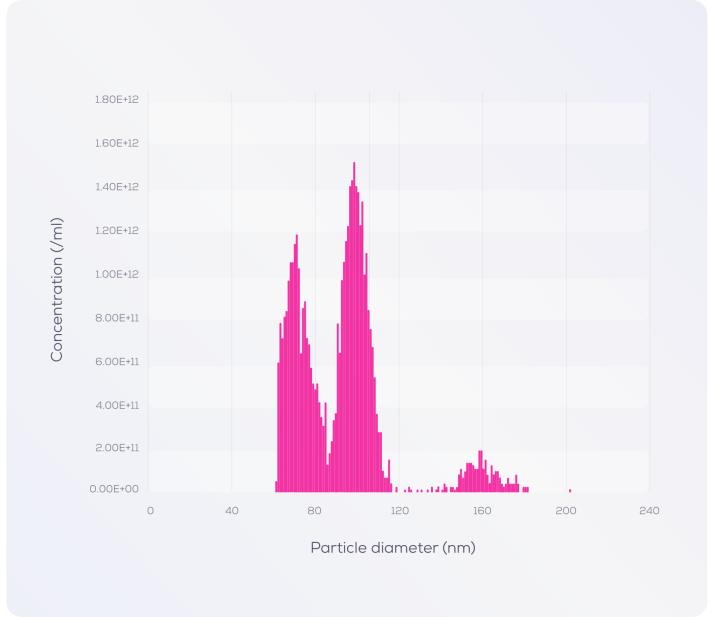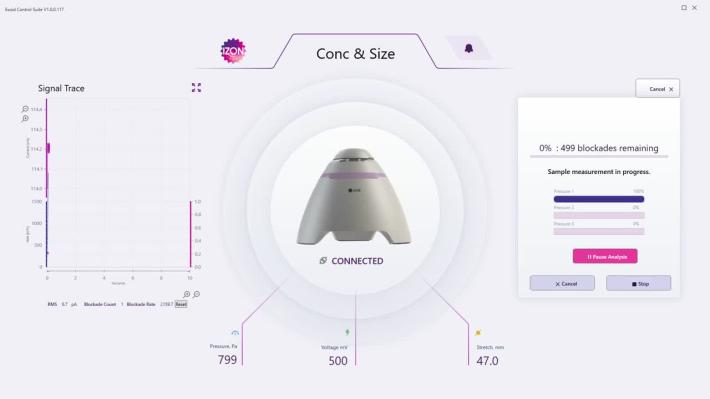Videos
Files
| Attachment | Size |
|---|---|
| 1.04 MB | |
| 144.22 KB |
News, events, promotions, webinars
Multi-parameter analysis of bio-nanoparticles is a critical aspect of research and product development. Achieve complex, multi-parameter analysis with minimal user input on the Exoid to vastly improve productivity and through put. Obtain excellent results and high-quality, consistent data with ease and minimal potential for user error due to the automation of pressure, voltage, and pore-size control.
Reliable measurement of complex samples
Characterise bio-nanoparticles accurately and reproducibly with minimal user input and without labour-intensive monitoring. Obtain high-resolution data of complex, heterogenous samples with high-resolution detection and quantification of subpopulations.
Obtain accurate data in real-time with confidence
Directly quantify bio-nanoparticles for diagnostic, research, or product development purposes. Assess sample aggregation or reaction progression over time. Be confident in your conclusions with precise and reproducible data.
Rapid and simple multi-parameter analysis
Measure particle size, concentration, and zeta potential simultaneously, over time, and/or for multimodal samples. The Exoid is the only instrument able to identify and analyse multiple parameters for up to four subpopulations of heterogenous biological samples.
The Exoid is the only standardisable method of measuring the entire nano range (1–1000 nm) and determining number-based size distribution, which are becoming requisites of many guidelines and regulations. Accurate analysis of bio-nanoparticles is challenging due to their size, tendency to aggregate, and heterogenous nature and limited by a lack of reliable, universally accepted, and validated methods of nanoparticle characterisation. The Exoid is at the forefront of bioanalysis; results not influenced by specific instrument settings or particle properties such as refractive index, making data reproducible and comparable. Exoid data are therefore suitable for regulatory purposes. Despite a historical reliance on ensemble techniques such as dynamic light scattering (DLS), the need for techniques with higher resolution and capable of providing accurate, single-particle data for smaller particles (<50 nm diameter) is recognised as being essential for progression in the field. The Exoid is fast becoming an essential aspect of bioanalysis worldwide.
The precision, resolution, and accuracy of TRPS nanoparticle measurement is well established. As the only technique to provide data of sufficient quality for bio-nanoparticle analysis, TRPS ensures the quality of your data and reproducibility of your results. Calibration with NIST-traceable particles enables inter- and intra-laboratory comparisons to be made with confidence, and ensures that data are suitable for regulatory purposes. Automated calibration means that results are delivered in real-time, giving quick insight into the nature of the sample or enabling evaluation of reaction progression/aggregation effects. Compared with indirect methods such as dynamic light scattering, the direct analysis offered by TRPS provides a true size distribution without artefacts or inaccuracies due to model fitting. Furthermore, direct counting removes the need for multi-step or complex protocols, and particles with different sizes, shapes, and surface properties can be quantified simultaneously with high accuracy and precision.
The Exoid is the only method of rapidly determining true particle concentration and size distribution in a high-throughput system.
The Exoid is the solution for complex analyses of bio-nanoparticles. Incorporating the unparalleled accuracy of TRPS into a semi-automated machine with high sensitivity and usability, the Exoid offers a simple "press-and-go" system for multi-parameter characterisation of particles as small as 40 nm in diameter with minimal sample preparation.
The Exoid calculates individual particle size, concentration, and zeta potential rapidly and simultaneously by measuring impedance across the pore 64,000 times per second. This ensures that every particle is detected and enables complex, high-throughput measurements which provide a true insight into the nature of your sample.
Particle size
Size calculations are not affected by optical properties, buffer composition, or other external factors. You can be certain of obtaining precise size measurements and size distribution data for your sample, even in the case of unknown or new samples.
Particle concentration
Concentration measurements are accurate on a linear scale, superior to other techniques that are accurate on a log scale only. Results can easily be compared between samples or replicates. Total particle concentration as well as concentration in each size band are analysed without the need for complex protocols or secondary analysis, providing a level detail unobtainable by other methods.
Zeta potential
Zeta potential is calculated by the sophisticated software of the Exoid after calibration with particles of known size, concentration, and surface charge. You can, therefore, be certain of the accuracy of your measurements.
Technical Features
Analysis Range | 40 nm to 10 µm |
Electrolyte properties | Physiological |
Footprint | 350 x 350 mm |
Concentration range | 1E5 to 1E11 / mL (size dependent) |
Weight | 10,5 Kg |
Height | 320 mm |


